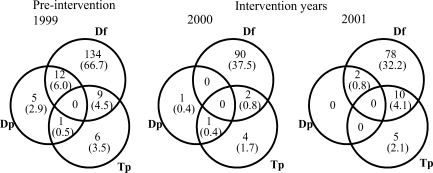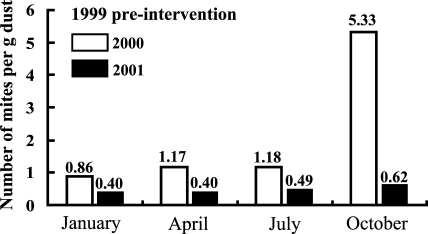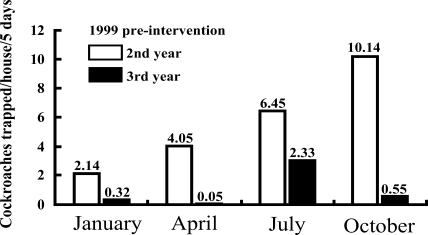Effectiveness of education for control of house dust mites and cockroaches in Seoul, Korea
Article information
Abstract
We evaluated the efficacy of health education in reducing indoor arthropod allergens in Seoul. The mite control measures comprised the use of mite-proof mattress and pillow coverings, regular washing of potentially infested materials, maintenance of a low humidity, removal of carpets, and frequent vacuum cleaning. Cockroach control measures included trapping, application of insecticides, and protecting food. Of 201 homes enrolled in October 1999, 63 volunteers were included in a 2-year follow-up survey between April 2000 and January 2002. Before intervention, the density of mites/g of dust varied greatly; 27.1/g in children's bedding, 20/g in adult bedding, 7.2/g on the floors of children's bedrooms, 6.8/g in sofas, 5.9/g on the floors of adult's bedrooms, 3.9/g on living room floors, 3.7/g in carpets, and 1.9 mites/g on kitchen floors. The predominant mite species and house percentages infested were; Dermatophagoides farinae 93%, D. pteronyssinus 9%, and Tyrophagus putrescentiae 8%. Comparing 1999 and 2001 infestations, before and after 25 mo of education, mite abundance was reduced by 98%, from 23.7 to 0.57 mites/g of dust. In 1999, cockroaches were detected in 62% homes: 36% Blattella germanica and 35% Periplaneta spp., including 9% double infestations of B. germanica and P. americana. Following intervention, cockroach infestation rates decreased to 22% of houses in 2000 and 23% in 2001. We conclude that continuous and repetitive health education resulted in the effective control of domestic arthropods.
INTRODUCTION
House dust mites and cockroaches are the most potent producers of indoor aeroallergens (Huss et al., 2001; Arlian, 2002; Jeong et al., 2006). Moreover, the human expressions of allergic diseases seem to be dependent on mites and cockroach densities, which are directly related to allergen levels in house dust (Van der Heide et al., 1997; van Strien et al., 1996). In particular, high exposure to house dust mite allergen during the first year of life has been found to increase the risk of subsequent mite sensitization and asthma (Sporik et al., 1990). A functional analysis of 'Bla g 2' a major allergen from Blattella germanica, the German cockroach (Arruda et al., 1995), suggested that environmental factors and genetic predispositions of individuals are the most critical elements for the development of allergic diseases (Pomes et al., 2002). Exposure to indoor allergens is believed to be more important than exposure to outdoor allergens, because exposure indoors is perennial; moreover, allergens are likely to be easier to control indoors. Thus, the avoidance of exposure to domestic allergens is considered a critical element of integrated strategies for the prevention and management of asthma (Tovey et al., 1999). It has been reported that the avoidance of dust mite allergen at high altitudes (above 1,500 m), where humidity is too low to support populations of house dust mites, has led to a decrease in airway inflammation and a consequent improvement in non-specific bronchial hyper-reactivity and symptoms, and that re-exposure results in rapid relapses (Piacentini et al., 1993). To assess the feasibility of reducing aeroallergens indoors in typical Korean homes, we evaluated the efficacy of health education and follow-up visits for the control of domestic arthropods.
MATERIALS AND METHODS
Period of examination
During October 1999 in Seoul, a total of 201 homes (54 bungalows, 102 apartments, 55 town houses) were enrolled for study, and 63 of these homes (17 bungalows, 28 apartments, 18 town houses) were monitored by surveying quarterly for 2 years. Education on aeroallergen reduction was offered from January 2000 onwards. Of the 63 houses enrolled in the follow-up surveys, 24 were the homes of allergic patients (bronchial asthma: 14, allergic rhinitis: 2, bronchial asthma and allergic rhinitis: 8).
Dust samples and cockroaches were collected from these 63 homes in October 1999, and quarterly during 2000 and 2001 (January, April, July and October). Instructions on the control of house dust mites and cockroaches were given in January 2000 before the follow-up study, and housekeepers were reminded of these control measures by administering questionnaires at every sampling visit.
Sites examined
Quarterly mite collections were undertaken in each home using a standard vacuum cleaner (LG V-318K, Seoul, Korea). Dust was sampled from up to 8 types of sampling site: bedding and floors of bedrooms (adults' and children's), living room and kitchen floors, and carpets and sofas, if present. For cockroach collection, 5 baited sticky traps (Trapper™, Jungoh Pharmaceutical, Seoul, Korea) were placed for 5 days in the kitchen. Trapped cockroach species were identified using standard morphological identification keys (Asahina, 1963). Cockroach infestations were found in only 22 homes during October 2000, and therefore, only these were investigated during 2001.
Isolation of mites
Dust was collected on filter paper positioned between vacuum cleaner extension tubes. One gram of collected dust was placed in 500 ml of 50% ethanol for 30 min with gentle stirring. The suspension was then filtered through 28 and 200 mesh sieves by flushing with tap water for 3 to 5 min. The wet fine dust that collected on the 200 mesh sieve was transferred into 500 ml of a saturated NaCl solution, and left for 30 min. It was then centrifuged at 500 g for 10 min and the supernatant was evenly spread on filter paper. Mites were picked out under a stereomicroscope, mounted individually in Hoyer's solution on a slide glass, examined under a compound microscope, and identified by referring to Wharton (1976) and Cho (1980).
Health education
From January 2000 onwards, health education on allergic diseases and indoor allergens and their reduction (due to house dust mites, cockroaches, fungal moulds and other environmental factors) was given to householders and volunteer members of families who involved during house visits arranged at convenient times. Using illustrated tutorials (a slide presentation was given at the first session in January 2000 and printed matter containing questions based on this presentation were given during subsequent visits), we described control methods found to be generally effective (Tovey and Mark, 1999; Eggleston, 2001). The instructions given for mite and cockroach control are summarized in Table 1. Subsequently, during each quarterly sampling visit, questionnaires were undertaken with housekeepers to remind them of the education received.
RESULTS
Dust mite infestations
In October 1999, before intervention, dust mites were detected in 167/201 (83%) of the homes surveyed, averaging 24 mites/g of dust with > 100 mites/g of dust in 7 houses (3.5%) and a maximum of 630/g. Dermatophagoides farinae was the predominant mite species, and was found in 93% (155/167) of the positive houses (mean density 20 ± 42.4/g dust), with D. pteronyssinus in 18 houses (9% of the total homes surveyed), whereas the storage mite Tyrophagus putrescentiae was found in 16 (8%) houses (Fig. 1). Double infestations with D. farinae were found in 12 homes with D. pteronyssinus and 9 homes with T. putrescentiae (see Fig. 1), but no triple species infestations were found. Mite mean density/g of dust varied greatly in different locations, i.e., in descending order of abundance for positive houses: 27.1 ± 45.9/g in child bedding, 20 ± 20.4/g in adult bedding, 7.2 ± 20.8/g on child bedroom floors, 6.8 ± 13.1/g in sofas, 5.9 ± 5.3/g adult bedroom floors, 3.9 ± 5.1/g on living room floors, 3.7 ± 4.6/g in carpets, and 1.9 ± 5.3 mites/g on kitchen floors.

Proportion of dust mites-infested houses (mean ± SD per house) in October 1999 pre-intervention, compared with 2000 and 2001 (quarterly surveys) after 1 and 2 years of enhanced intervention in the form of repetitive health education on aeroallergen control. Df, Dermatophagoides farinae; Dp, Dermatophagoides pteronyssinus; Tp, Tyrophagus putrescentiae.
After repetitive education, the proportions of houses with detectable mite infestation fell to 39-40% in years 2000-2001 from 83% in October 1999 (Table 2). Densities of D. farinae reduced to only 2.1 ± 3.8/g dust (quarterly mean of 60 houses) after a year of control, and to 0.53 ± 0.5 mites/g of dust (quarterly mean of 63 houses) after 2 years of control. Mites remained most prevalent in bedding, especially adult bedding (Table 2). Sofas were most neglected by housekeepers (infestation rates 56%, 73% and 33% in successive years) and carpets were easily removed. After 25 mo of intervention, mattresses and pillows had been encased in 32% (20/63) of homes, which effectively reduced D. farinae density to 0.3 ± 0.1/g of dust in bedding samples (i.e., by 95% versus pre-intervention). We did not isolate any mites from encased mattresses and pillows from 18 homes except in one case where encased mattresses and non-encased bedspreads were used. All mites detected during the second year of intervention were from non-encased beddings. Thus, encasing may be one of the most effective methods of controlling dust mites. T. putrescentiae was mainly detected in kitchens, their main habitat, and 3 cases (1 in a bedroom and 2 in a living room, both in close proximity to a kitchen) in other locations were believed to be due to kitchen associated. Mite densities were found to fall in January because of the low humidity in heated rooms, and conversely highest densities were observed in October because of the humidity in Korea at this time (Fig. 2).
Cockroach infestations
At baseline in 1999, cockroaches were found in 62% (107/174) of homes, i.e., 63 with B. germanica, 60 with Periplaneta spp., which included 16 homes with double infestations (Table 3). Periplaneta infestations comprised 2 homes with P. japonica, 3 with P. fuliginosa, and 39 (65%) with P. americana, but no multiple species infestations were noted (Table 3). With education and enhanced control, the proportion of houses in which cockroaches were trapped decreased to 22% in 2000 and remained near that level in 2001. Moreover, cockroach quarterly densities (5 traps/home for 5 nights) fell from 36.4 ± 19.7/house in 1999 to 5.7 ± 3.5/house in 2000, and further to 0.8 ± 1.0/house in 2001 (Fig. 3). Thus, the proportion of houses without detectable cockroaches rose from 38.5% pre-intervention to around 77% post-intervention (Table 3). Moreover, while these reductions were almost equally effective against B. germanica and P. americana, the incidence of P. japonica increased significantly (from 1.1% in October 1999 to 9.1% in October 2000 and 5.7% in October 2001).
DISCUSSION
The prevalence of childhood atopic disease appears to be increasing globally (Zeiger and Heller, 1995) and environmental factors are believed to play important causative roles (Peat et al., 1995). House dust mite allergen concentrations (µg/g) and densities (µg/m2) were found by Couper et al. (1998) to be related to several environmental factors in the homes of 1-moold infants in Tasmania.
We previously described the fauna and distribution of house dust mites in Korea (Ree et al., 1997). In the U.S.A., a density of 100 mites/g of dust is considered to be the threshold of sensitivity (Korsgaard, 1983), but the threshold in Korea could be at much lower mite densities, because of an exceptionally high average amount of Der f 2 (allergen secreted from the mite anterior midgut and concentrated in fecal pellets) (Jeong et al., 2002b) estimated to be 25.6 ± 10.7 µg/g in dust obtained from bedding samples from 89 homes (Jeong et al., 2002a) whereas 4.3 µg/g of mite group 2 allergens was detected from 47 dust samples in Japan (Yasueda et al., 1989). In addition, nearly all bedding samples (86 of 89) collected in Seoul homes were found to contain Der f 2 (range 2-50 µg/g of dust), which is a putative sensitization risk factor for patients allergic to mites. Dust mite densities were observed to fluctuate seasonally with a maximum in October and a minimum in January, which concurs with a previous Korean report (Paik et al., 1991). Thus, same month comparisons could give more accurate year-on-year data.
The amount of cockroach allergen exposure required to cause sensitization is not clearly defined, but a recent epidemiological study showed that dust concentrations of > 0.32 µg/g of cockroach allergens elicit IgE responses similar to those obtained from the dust mite or cats at 10 to 100-fold higher levels (Sporik et al., 1999). Thus, cockroaches deserve more attention in Korea because the domestic infestation rate of Periplaneta americana in Seoul was found to be far greater in this study (32%) than in previous reports (e.g. 4.5%: Kwon et al., 1993).
The severity of allergic disorders is related to allergen exposure and recommendations are usually given to patients concerning reducing indoor allergen levels, but the efficacies of such approaches vary. Asthma is unequivocally associated with cockroach infestation and attempts to reduce cockroach allergen exposure rely heavily on improving patient education (Custovic et al., 1998). Moreover, it was described that reduction in number of cockroaches and in total allergen in bedding dust could be achieved by educational intervention by peer educators (McConnell et al., 2005). Home visits are a strong stimulus for changing the behaviors of housekeepers, i.e., by promoting more frequent cleaning, and the removal of mite habitats such as carpets. The methods and the effectiveness of indoor environmental management can be described, but there is a need to develop a large-scale trial on the practicalities of allergen avoidance, and to determine the effect of such schemes on patient symptoms, and overall health costs (Eggleston, 2001). In particular, several lines of study have suggested that allergen avoidance in childhood can reduce the prevalence of sensitization (Arshad et al., 1992; Wahn et al., 1997). However, it is uncertain whether such measures reduce symptoms because of the complicating effects of treatments.
When asthmatics become aware of the benefits that accrue from adequate mite control, they can adopt control measures that effectively reduce mite densities in their homes (Dorward et al., 1988; Platts-Mills and Chapman, 1987). Acaricides and permethrin-impregnated mattress-covers can be highly effective against dust mites (Cameron, 1997; Cameron and Hill, 2002). Moreover, contrary to the proposal by Colloff (1990) that for specific nutritive reasons, mites thrive best in adult bedding, our data indicate that mite densities are higher child bedding, though prevalences were equivalent. Cultural differences may provide an explanation for this discrepancy. Almost all Korean houses have 'ondol' heating (a Korean under-floor heating system). Usually adults store bedclothes in furniture during the daytime, and lay a bed on the bedroom floor in the evening, whereas children, especially preschool children, tend not to store bedding during the day, possibly creating a better habitat for dust mites.
In conclusion, health education and follow-up visits were found to significantly reduce the densities of indoor arthropods, and thus probably reduced patients' symptom severity and incidences. The best way of treating allergic disease is believed to be a combination of environmental control and medication. It is recommended that continuous and repeated health education, at a frequency of more than once a year, is required for effective control of indoor allergens.
Notes
This study was supported by a research grant from the Development of Health and Medical Technology program (HMP-99-M-09-0006) of the Ministry of Health and Welfare, Republic of Korea.




